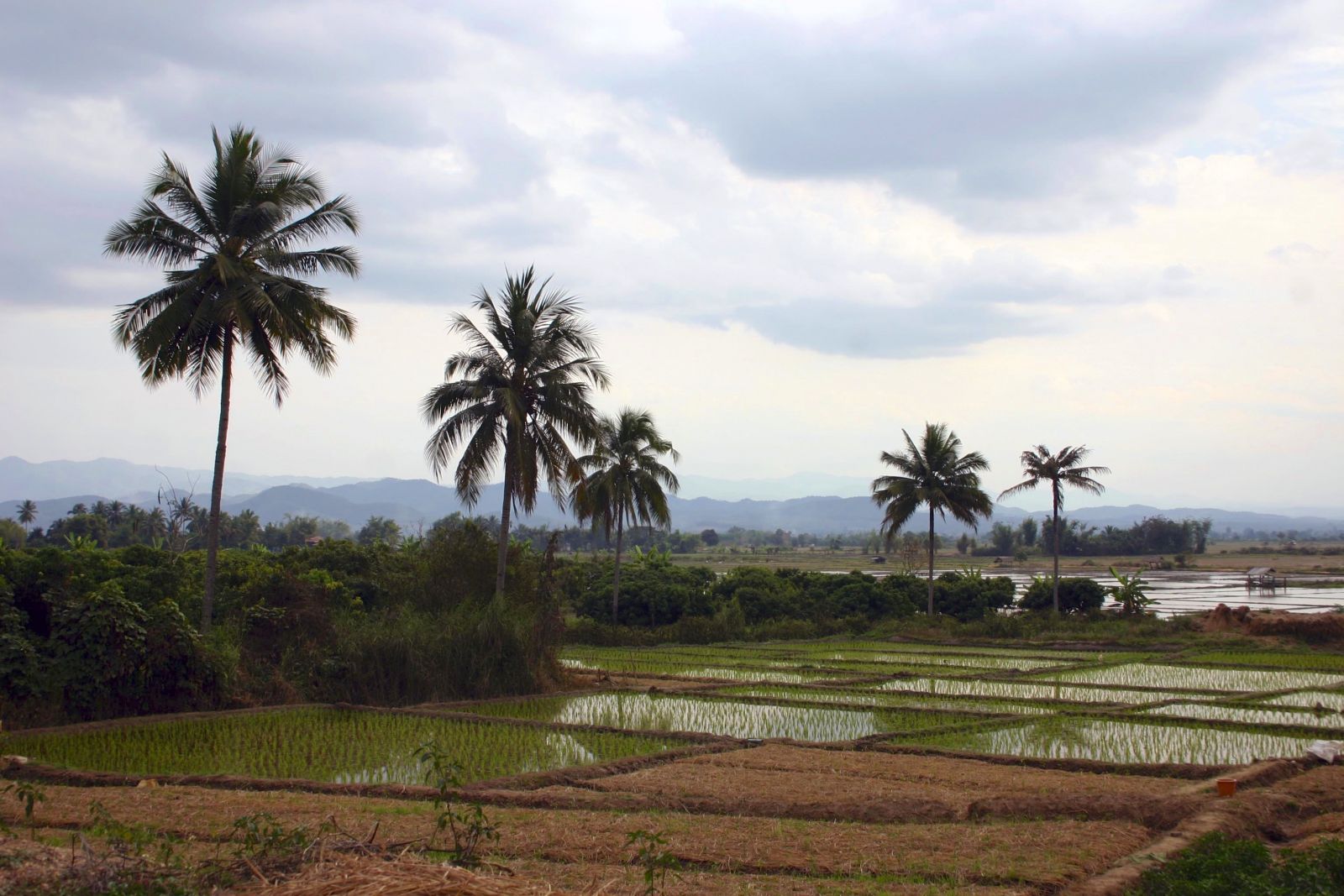Mapping a literature การระบุเขตแดนแห่งอักษรธรรม
The situation of Buddhist manuscripts in northern Thailand is remarkable. Manuscripts (generally on palm leaves or bai lan and mulberry paper or phap sa) can be found all over the northern provinces of the Kingdom (Chiang Mai, Chiang Rai, Lampang, Lamphun, Nan, Phayao, and Phrae). Manuscripts are all written in tham script and in different languages, most of them in Tai (Yuan or phuen mueang, Khuen and Lue) but also in Pāli. In the province of Mae Hong Son the manuscripts belong to the Tai Yai or Shan culture and are quite different paleographically and linguistically.
The collections have either been kept in their numerous original repositories inside a monastery (the local ho tham of the wat) or they have in some cases been grouped together in a leading monastic centre. They can be found from the the northernmost point of Thailand, Chiang Saen to the the southernmost point of the ancient kingdom of Lanna, Thoen. It is necessary to realize, however, that cultural boundaries do not correspond to the political boundaries of modern Thailand: the culture of Lanna — whose territory and status have been changing over the centuries — extends well into neighboring countries (Burma, China and Laos). It is the common use of a single alphabet to write texts fully understandable from one region to the other, that allows us to define an extended area of civilizations. Hans Penth called this shared cultural area “Culture of the Region of the Dhamma Letters”. This area extended to the cities and kingdoms of Luang Prabang in Laos (Lan Chang), Chiang Tung in Burma (the Khuen country in the Easternmost Shan States) and Chiang Rung in Chinese Yunnan (the Lue country of Sipsong Panna).
Thanks to the willingness of local religious and secular communities to keep the manuscripts in their places of origin, very few collections have been “exported” from monasteries, in or outside the boundaries of Lanna. For instance, the National Library of Thailand (in Bangkok and Chiang Mai) does not hold as large a collection as one would expect: in one of the most important category, the tamnan, only 101 stories or titles are available in the National Library in Bangkok (if we can trust the card catalogue there). This is indeed a very low figure when we know of the hundreds of thousands of manuscripts preserved, but scattered, all over the northern region.
คัมภีร์ทางพุทธศาสนาที่มีอยู่ทางภาคเหนือของประเทศไทยนั้นมีความพิเศษเป็นอย่างยิ่ง เราสามารถพบคัมภีร์เหล่านี้ทั้งในรูปของพับสา (คัมภีร์ที่เขียนบนกระดาษสา) และใบลานได้ทั่วไปในเขตจังหวัดต่างๆ ทางภาคเหนือของราชอาณาจักรไทย (เชียงใหม่ เชียงราย ลำปาง ลำพูน น่าน พะเยา และแพร่) คัมภีร์เหล่านี้ทั้งหมดเขียนขึ้นโดยใช้ ตัวธรรม เป็นอักษรจารึกภาษาต่างๆ ซึ่งส่วนใหญ่คือภาษาไท (ไทยวน หรือไทพื้นเมืองของทางภาคเหนือ, ไทเขิน และไทลื้อ) แต่ก็มีที่เขียนลงเป็นภาษาบาลีด้วย ส่วนในพื้นที่จังหวัดแม่ฮ่องสอนนั้นคัมภีร์ที่พบเป็นส่วนหนึ่งของวัฒนธรรมไทใหญ่หรือฉานซึ่งมีลักษณะที่ต่างกันออกไปทั้งทางด้านภาษาศาสตร์ (Linguistics) และอักขรวิทยา (paleography)
กลุ่มคัมภีร์เหล่านี้ ส่วนหนึ่งได้รับการเก็บรักษาไว้ในหอธรรมดั้งเดิมของวัด หรือในบางกรณีอาจถูกรวบรวมเข้าไว้ด้วยกันที่วัดสำคัญซึ่งเป็นศูนย์กลางของชุมชนหนึ่งๆ เราสามารถพบชุดคัมภีร์ดังกล่าวได้ตั้งแต่เขตเหนือสุดของประเทศไทยที่อำเภอเชียงแสน จังหวัดเชียงราย ไปจนพรมแดนใต้สุดของอาณาจักรล้านนาเดิม ที่อำเภอเถิน จังหวัดลำปาง ข้อสังเกตสำคัญก็คือ พรมแดนทางวัฒนธรรมที่มีมาแต่เดิมไม่ได้เป็นอันหนึ่งอันเดียวกับเส้นแบ่งเขตแดนการปกครองของประเทศไทยปัจจุบัน หลายศตวรรษที่ผ่านมานี้ วัฒนธรรมล้านนาได้มีความเปลี่ยนแปลงไปทั้งทางด้านอาณาเขตและสถานภาพ ทำให้วัฒนธรรมล้านนาสามารถที่จะมีการขยายตัวออกไปยังพื้นที่ของประเทศเพื่อนบ้านอื่นๆ ด้วย (ประเทศพม่า ประเทศจีน และประเทศลาว) การใช้อักษรแบบเดียวกันในการจารึกวรรณกรรมให้เป็นที่เข้าใจร่วมกันได้ระหว่างเขตพื้นที่ต่างๆ คือเงื่อนไขที่ทำให้เราสามารถระบุเขตแดนหรือพรมแดนของอารยธรรมหนึ่งๆ ได้ Hans Penth ได้เรียกพื้นที่ซึ่งมีวัฒนธรรมร่วมกันนี้ว่า “วัฒนธรรมของเขตแดนแห่งอักษรธรรม” (“Culture of the Region of the Dhamma Letters”) โดยที่เขตแดนดังกล่าวนี้ได้ขยายตัวออกไปยังพื้นที่เมืองและอาณาจักรต่างๆ อาทิ หลวงพระบางในประเทศลาว (อาณาจักรล้านช้าง) เชียงตุงในประเทศพม่า (เมืองเขินในภาคตะวันออกของรัฐฉาน) และเชียงรุ้งในมณฑลยูนนานของจีน (เมืองลื้อในสิบสองปันนา) เป็นต้น
ต้องขอขอบคุณความตั้งใจอันดีของกลุ่มผู้มีจิตศรัทธาและนักวิชาการที่มุ่งเก็บรักษาคัมภีร์เหล่านี้ไว้ยังสถานที่เก็บดั้งเดิม ชุดคัมภีร์ที่หลุดลอดออกไปจากหอธรรมของวัดต่างๆ ในพื้นที่ซึ่งเคยเป็นของอาณาจักรล้านนาจึงมีเพียงจำนวนน้อย ดังจะเห็นได้ว่า หอจดหมายเหตุแห่งชาติทั้งในกรุงเทพฯและในเชียงใหม่ก็ไม่ได้มีชุดคัมภีร์ล้านนามากอย่างที่เข้าใจกัน เฉพาะที่หอจดหมายเหตุฯ ในกรุงเทพฯ เราอาจพบกลุ่มคัมภีร์สำคัญในประเภทตำนานแค่เพียง 101 เรื่องหรือหัวเรื่องเท่านั้น (หากเราสามารถเชื่อถือจำนวนที่ระบุไว้ในระบบค้นเอกสารของหอจดหมายเหตุได้) ไม่ว่าอย่างไรก็ตาม จำนวนที่กล่าวถึงนี้ถือเป็นจำนวนที่น้อยมากเมื่อเทียบกับจำนวนคัมภีร์เป็นแสนๆ เล่มที่เก็บรักษาไว้ในพื้นที่ภาคเหนือ แม้ว่าจะกระจัดกระจายกันไปตามหอธรรมย่อยต่างๆ ก็ตามที

